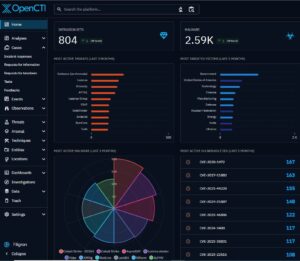In today’s rapidly evolving cybersecurity landscape, organizations must stay ahead of emerging threats by leveraging robust cyber threat intelligence (CTI) platforms. OpenCTI (Open Cyber Threat Intelligence) is an open-source platform designed to help organizations manage, analyze, and share threat intelligence efficiently. By integrating OpenCTI into your cybersecurity workflow, you can enhance threat detection, improve decision-making, and streamline intelligence-sharing processes. This article explores the key benefits of OpenCTI and why it is an essential tool for cybersecurity teams.

1. Centralized Threat Intelligence Management
One of OpenCTI’s core strengths is its ability to centralize all cyber threat intelligence in a single, structured repository. Security teams often deal with fragmented data sources, making it difficult to correlate and analyze threats effectively. OpenCTI provides a unified platform that ingests data from multiple sources, including open-source feeds, commercial threat intelligence providers, and internal security logs.
2. Advanced Data Structuring and Correlation
OpenCTI follows the STIX (Structured Threat Information eXpression) standard, allowing it to structure and model intelligence data consistently. This structured approach enhances the correlation of threat indicators, making it easier to detect patterns and understand the relationships between different threat actors, campaigns, and attack techniques.
3. Seamless Integration with Security Tools
A significant advantage of OpenCTI is its flexibility in integrating with various security tools, such as SIEM (Security Information and Event Management) systems, SOAR (Security Orchestration, Automation, and Response) platforms, IDS/IPS (Intrusion Detection/Prevention Systems), and endpoint security solutions. By integrating OpenCTI with existing security infrastructure, organizations can automate threat intelligence workflows and improve incident response times.
4. Real-Time Threat Intelligence Sharing
Cybersecurity is a collaborative effort, and OpenCTI facilitates real-time threat intelligence sharing among organizations, industry groups, and government agencies. The platform supports data exchange through standards like TAXII (Trusted Automated Exchange of Intelligence Information), enabling seamless and secure sharing of intelligence with trusted partners.
5. Customization and Scalability
OpenCTI is highly customizable, allowing organizations to tailor the platform to their specific threat intelligence needs. Security teams can define custom data models, automation rules, and dashboards to enhance visibility into relevant threats. Additionally, its scalable architecture ensures that organizations of all sizes can manage growing volumes of threat intelligence without performance bottlenecks.
6. Open-Source and Community-Driven
Unlike proprietary CTI platforms, OpenCTI is open-source, meaning organizations can deploy and modify it without expensive licensing fees. The active OpenCTI community continuously contributes to its development, ensuring regular updates, improvements, and integrations with new security technologies.
7. Improved Incident Response and Threat Hunting
By leveraging OpenCTI, security analysts can enrich incident investigations with contextual threat intelligence, making it easier to identify Indicators of Compromise (IoCs) and understand attack techniques. The platform’s ability to correlate intelligence data with historical incidents also enhances proactive threat hunting efforts, helping organizations detect and mitigate threats before they cause damage.
